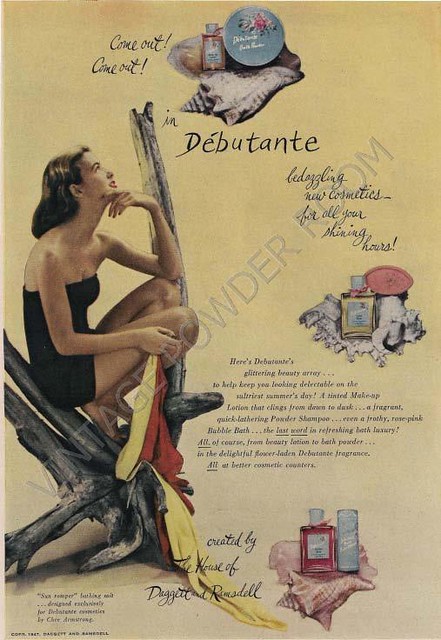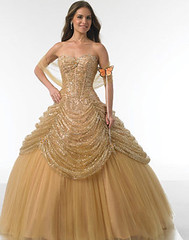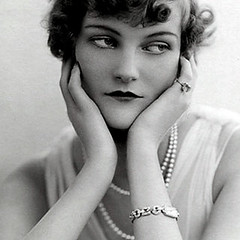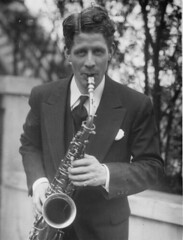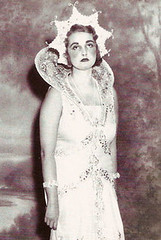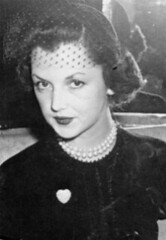Tue 31 Aug, 2010
DEBUTANTE
Comments (0) Filed under: AdvertisementsTags: anoreia, Astor, Barabara Hutton, Barbara Hutton, Cary Grant, debutante, Diane Arbus, Doris Duke, Glamour Girl, Great Depression, Kurt Haugwitz-Reventlow, Maurice Chevalier, Paris Hilton, Quinceanero, Rockfeller, Rudy Vallee, Woolworth's
This wonderful 1947 advertisement showcases Daggett and Ramsdell’s Debutante collection of cosmetics.
The ad calls “Come out! Come out!” which is, of course, a reference to the “coming out” parties or cotillion balls which were held to introduce a young lady (known as a debutante) from an aristocratic or upper class family to society.
The rich are not like you and me.
The idea for the parties was to literally bring a girl out and display her to eligible bachelors and their families with an eye to marrying her off to someone within a select circle of people. An early incarnation of TV’s popular “The Bachelor”.
There are many versions of a coming out party in different cultures. Here in Los Angeles most of us are familiar with a Quinceañera, Quince, Quinceañero or Quince años (English: “fifteen years”) which is a Latin American coming of age ceremony for a girl marking the transition from girlhood to womanhood.
If you drive around Los Angeles on the weekends you’ll often see these ceremonies taking place. They are just as elaborate as any wedding. Planning for the Quinceañera begins at least one year in advance and involves family, friends, and a priest who will perform the ceremony in church.
The word debutante comes from the French débutante, and means “female beginner”. They were at their zenith during the nineteenth century; however, they exist to this day.
Personally, I’m fascinated by the American debutantes of the 1930s. The Depression era must have been a peculiar time to be a “deb”. Maybe that’s why magazines of the period focused on “poor little rich girls” like Doris Duke and Barbara Hutton. Perhaps the fact that many of the debutantes had unhappy lives made their riches to riches stories more palatable to a woman in a bread line.
Born in New York City, Barbara Hutton was the only child of Edna Woolworth (1883–1918), who was a daughter of Frank W. Woolworth, the founder of the successful Woolworth five and dime stores. Barbara’s father was Franklyn Laws Hutton (1877–1940), a wealthy co-founder of E. F. Hutton & Company (owned by Franklyn’s brother Edward Francis Hutton), a respected New York investment banking and stock brokerage firm.
Barbara Hutton came out on her eighteenth birthday on November 14, 1930. At the time an average ball cost around $16,000, ($208,872.81 in current dollars). Barbara Hutton’s debutante ball cost over $60,000 ($783,273.05 in current dollars). Who attended this party? The people that you would have expected to have been there, the Astor and Rockefeller families to name two. The guests were entertained by crooners Rudy Vallee and Maurice Chevalier.
While the average family was struggling to make ends meet during the 1930s, girls like Barbara were coming out to continue their lives of wealth and privilege. It is no surprise that public criticism was so severe that Hutton was sent on a tour of Europe to escape the scrutiny of the press and the disdain of the public at large.
By the time of Hutton’s twenty-first birthday in 1933 she had trust fund worth roughly $2 billion in today’s money. Ironically much of Hutton’s fortune came from the Woolworth five and dime stores – places she would never have to shop.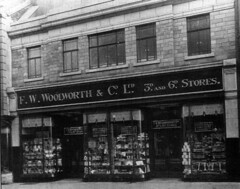
Actually though, there appears to have been a kernel of truth to the “poor little rich girl” moniker. Barbara’s life may have been lived in the finest clothes and spent in the most sumptuous of surroundings but, by all accounts, she was never happy. The things that money couldn’t buy continued to elude her – for example, a happy marriage. She tried marriage seven times, each ended in divorce. None of the men seemed to possess much in terms of wealth or character.
Her first two husbands used her great wealth to their advantage, especially the extremely abusive Kurt Haugwitz-Reventlow, with whom she had her only child, a son named Lance. (Lance would die tragically at 36 in a small plane crash.) Reventlow was verbally and physically abusive. He finally beat her so savagely that she was hospitalized and he was tossed into the slammer. He had even managed to convince her to relinquish her American citizenship and to take his native Danish citizenship for tax purposes, which she did in 1937 in a New York federal court. Reventlow’s constant abuse led Barbara to drug abuse, and to anorexia (from which she would suffer intermittently throughout the rest of her life).
Cary Grant, to whom she was married from 1942-1945, appears to have been the only one of her husbands who sincerely cared for her. The couple was dubbed “Cash and Cary” by the press but Grant, who had enough money and fame of his own, didn’t need anything from his wealthy wife. She would continue to describe him as the only decent man she’d ever married.
Barbara Hutton would continue to fascinate people but arguably the most famous of the 1930s debutantes was Brenda Duff Frazier.
Brenda Diana Duff Frazier’s December 1938 coming out party was so heavily publicized worldwide she eventually appeared on the cover of Life magazine for that reason alone.
Brenda’s father, Frank Duff Frazier, came from a prosperous Boston family. Her mother, the former Brenda Germaine Henshaw Williams-Taylor, was the only daughter of Sir Frederick Williams-Taylor. He was a general manager of the Bank of Montreal who was knighted in 1910 and combined his middle name and birth surname into a new hyphenated surname. A hyphenated name sounds much ritzier, don’t you think? Brenda’s parents eventually divorced, causing little Brenda to spend much time with her social-climbing maternal grandmother.
If you thought, as I did, that the term celebutante was coined recently for the likes of Paris Hilton – well, we’re wrong! The term was created in 1939 to describe Brenda.
Brenda was greatly admired and often copied during the years when she was dubbed “Glamour Girl #1”. She anticipated Goth girls by decades when she popularized her famous “white-face” look. She used a very light colored face powder which made a stark contrast to her red lips and deep brunette hair. Fame comes at a price though – Brenda frequently suffered with a stiff neck because she was afraid to move her head, lest she displace a single hair in her perfect coiffure. Brenda also started a trend when she was photographed wearing a strapless white velvet dress. Strapless gowns quickly became a must have for women of all ages – and they remain a classic style.
Like the other “poor little rich girls”, the debs of the 1930s, Brenda’s life appeared enchanted when viewed from the outside. Sadly, like her fellow debs she was also unlucky in love. She was married twice, both unions ended in divorce. And, as Barbara Hutton had done, she suffered from anorexia throughout her life.
Eventually Brenda must have tired of the endless parties because she withdrew from the public eye for years. She may have slipped away unnoticed had she not been revealed at the end of her life in a photo by Diane Arbus.
If nothing else the photo serves as cautionary tale for those daughters of the fabulously wealthy who lead lives of excess without substance.
Paris, take note.
